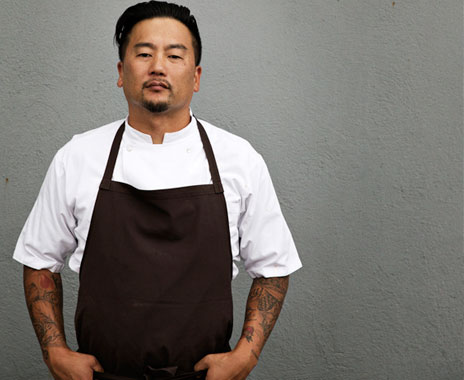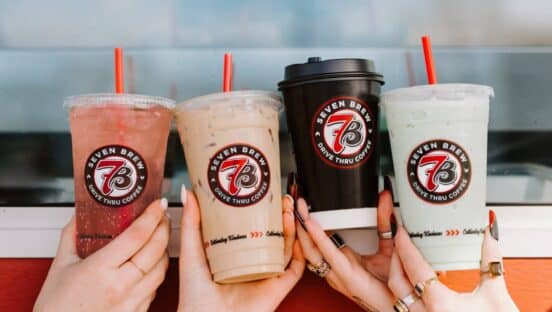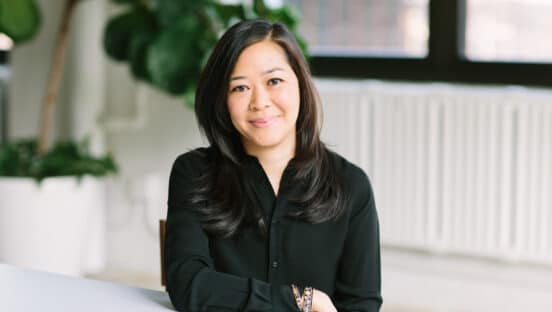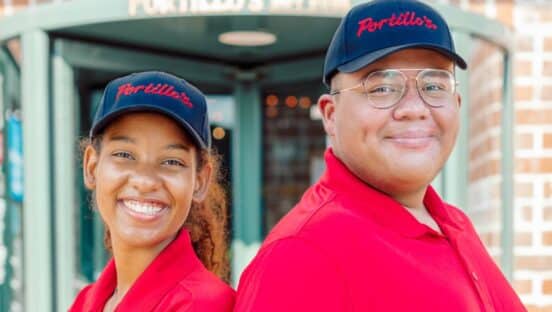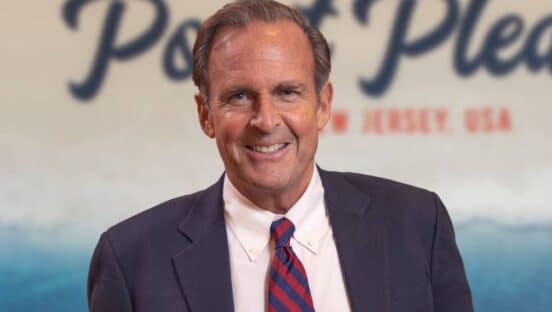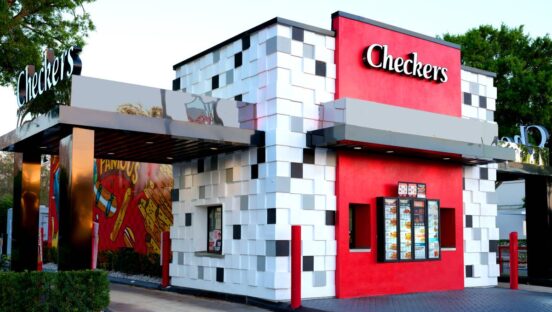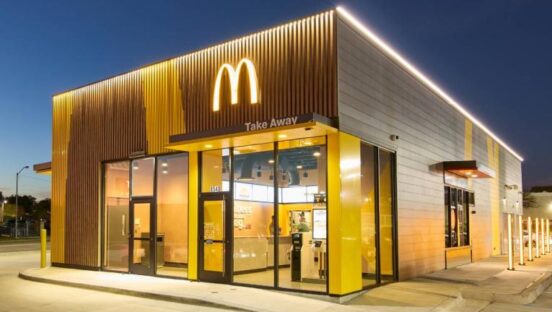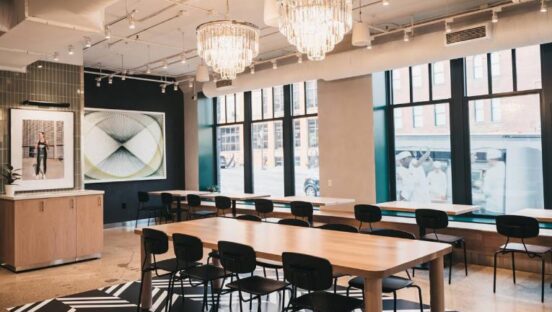The phone number is emailed to me, and I’m surprised to see it’s only 10 digits. No dial-in information, no confirmation code, no announce yourself after the beep. Just a plain and simple phone number, area code Los Angeles.
I’m surprised because this phone number belongs to Roy Choi, celebrity chef, godfather of the food-truck movement, host of the new CNN show “Street Food with Roy Choi.” Foodservice pros of his stature often come with handlers, with spokespeople, with carefully timed 15-minute windows. But Choi is accessible through these 10 numbers and just two rings, and we talk for nearly 45 minutes about Loco’l, his new quick-service project with San Francisco chef Daniel Patterson that the pair announced at the MAD Symposium in Copenhagen, Denmark, in August.
Choi speaks candidly about the restaurant concept, peppering his comments with words that would require the whole set of symbols from the number keys of a keyboard. He doesn’t talk in sound bytes or from a script. He thinks out loud, sometimes drifting off in conversation like he’s dreaming up ideas for the project on the spot. These are important things to note because to do what Choi wants to do, he’ll have to dream big. He’ll have to keep free of a script, have to stay open and honest with himself, with Patterson, with the American public.
Because what Choi wants to do with Loco’l is no small feat: He wants to change fast food forever.
“The goals are to bring delicious, nutritious food at affordable prices,” Choi says. “That’s our mission statement, really, to never lose sight of that, to never lose our equilibrium as to which way is up and which way is down, never let money dictate what it is we’re going to do, because that’s not how we live as chefs in our restaurants.”
Sounds simple enough, but Choi and Patterson aren’t envisioning this on a small scale. This is no five-unit, Hollywood Hills trendsetter they’ve dreamed up. They want Loco’l to become a household name, to sit in the same strips across the country as McDonald’s, Burger King, and Taco Bell. They want to offer burgers, fries, and other standard fast-food offerings, but make them with healthy, natural ingredients and sell them for competitive prices, somewhere in the $2–$3 range.
Right now, the concept is still in ideation phase. Patterson and Choi are looking for investors and real estate—the first Loco’l will open in San Francisco’s Tenderloin district, while a unit in Oakland, California, won’t be far behind—and Choi says they’ll start piecing together the menu by the end of the year, as well as developing what Loco’l looks like, smells like, feels like. Whereas most of these details are already stitched up when a venture such as Loco’l is publicly announced, Choi says he and Patterson wanted to get the news out there early to challenge themselves and to surround themselves with the brightest minds in foodservice.
“It’s not much different than what we do as chefs every day,” Choi says. “Sometimes we write a menu, then we’ve got to go prep it. Sometimes we’ll go to the market or a farm and we’ll gather a bunch of stuff and then throw it on the table and be like, ‘OK, we’ve got to make a meal.’ That’s the way we’re looking at it now.”
What chefs do every day—that’s really the crux of what Choi and Patterson hope Loco’l can become. They want to apply the chef mentality, the chef process to the mass foodservice market. That’s the idea that originally brought them together; the two met in Copenhagen at the 2013 MAD Symposium—a sort of TED Talks–style event for the food community, organized by renowned Denmark chef René Redzepi—where Choi gave a speech that challenged chefs to feed not just people who could afford to come into their restaurants, but the people who lived in impoverished neighborhoods without access to healthy foods. Both chefs were already dedicated to the cause. Choi spent some of his childhood growing up in poor Los Angeles neighborhoods and is passionate about serving poor communities and teaching younger generations how to cook, which he does at the L.A. nonprofit A Place Called Home. Patterson, meanwhile, helped launch The Cooking Project in San Francisco, an initiative that teaches kids and young adults on the streets how to cook.
And both think that now is the time to leverage chefs’ power and influence to make significant change in the national foodservice industry.
“For many years, chefs didn’t have a voice. We were stuck in the back. And now that we have a voice, this is what we’re doing with it,” Choi says. “In a way, it’s very punk rock. It’s very DIY, looking at everything, scrutinizing everything, not believing what is being told to us, and breaking it apart and saying, ‘We don’t believe you. And we’re going to show you and break it apart and then give it back to you.’ That’s what Loco’l is. We’re trying to do that on every angle. We’re trying to do that with the food, with the supply chain, with our purveyors, the small farmers, with the people who are interested and involved with the food community already.”
Of course, Choi isn’t the first high-profile chef to establish a presence in the limited-service restaurant industry. Ever since Wolfgang Puck opened his first Wolfgang Puck Express in San Francisco’s Union Square Macy’s in 1991, the space has tempted celebrity and otherwise fine-dining chefs to try their hand, leading to a host of big names—Rick Bayless, Tom Colicchio, Michael Voltaggio, Bobby Flay, Danny Meyer—rolling out their own limited-service brands. This year has been an especially significant year for the chef trickle-down; along with Choi and Patterson, chefs Jose Andres and Carla Hall have each announced their intentions to open quick-service concepts.
Choi has high praise for what other chefs have accomplished in quick service, but says it hasn’t gone far enough toward changing the entire food system. He calls the movement so far the “first wave,” whereas Loco’l will belong to a second wave that takes a chef approach and applies it to the value-first, convenience-minded nature of fast food.
“It brought flavor, it brought a new look, I think, a new look and a new audience to fast food again,” Choi says of that first wave. “But one thing it hasn’t done, I don’t think, is it hasn’t given options to people who can’t afford anything beyond McDonald’s or Burger King or KFC. That’s not the fault of Rick [Bayless] or Danny [Meyer] or anyone like that, it’s just sometimes you need a first wave of things. They laid a certain foundation for that.”
Other chefs are already building on that foundation. Steve Ells, of course, did so with Chipotle, which sticks closely to its “Food with Integrity” mission by sourcing more natural and local ingredients than most chains. But even Chipotle, Choi says, is more of a premium option than what he envisions for Loco’l, more fast casual than fast food, a higher average ticket than what many in less-fortunate neighborhoods can afford.
[pagebreak]
Fast casual has so far been the back door through which many chefs have entered the limited-service space, though. Jeremy Barlow, founder of Nashville-based sandwich concept Sloco and former chef and owner at fine-dining restaurant Tayst, believes the explosion of the fast-casual segment has given chefs like him the vehicle they need to get their premium foods in front of a national audience. While Sloco so far only has two stores open, Barlow envisions the shop—where the average price for a sandwich is $7.31—to grow across the country, using only sustainable, local, and organic ingredients.
To create some semblance of consistency between stores in disparate markets, he says, he wrote the menu in “broad strokes” so that individual stores could be creative with what they offered. For example, instead of the menu stating that a sandwich has lettuce, it says it has “greens,” leaving the door open for the operator to source whatever varieties are in season. The operating model Barlow designed for potential franchisees or expansion partners includes a central commissary through which a chef prepares all of the foods for the restaurants.
“So whatever region we go into, we start with a central store with a commercial kitchen, where I have a chef,” he says. “And I guarantee you, in every city in this country, there’s a chef like me coming from the fine-dining world who’s stoked to see his family and get nights off and … they don’t want to lose the cooking part, but they want to change their hours and change the lifestyle a little bit.”
The fast-casual industry’s incredible growth, and the potential that chefs like Choi, Patterson, and Barlow see to evolve the entire restaurant industry and food supply chain, has encouraged culinary schools like the Culinary Institute of America (CIA) to embrace it as a viable career choice for students. Ron Hayes, director of career services at the CIA, says the negative stigma of the limited-service industry is starting to wane among students as more high-profile chefs prove its potential.
“Students are becoming much more receptive to that because of the long-term career path,” Hayes says. “You can grow continuously, generally have a decent benefits package, and you have a trajectory as opposed to entering into just one fine-dining restaurant.”
He adds that students—who are trained by the CIA to work in high-volume kitchens—are increasingly intrigued by the opportunity to become entrepreneurs instead of just chefs, with the potential to expand their reach and business acumen through franchising or other growth channels. “I talk with students sometimes and they say, ‘I don’t want to work in a corporate environment.’ Well, Daniel Boulud is a corporate environment, and how many Michelin stars does he have? Thomas Keller, how many Michelin stars? That’s a corporation,” he says. “So there’s definitely some redefining [to do]. But I think as students see the possibilities and see what you can really do, it opens so many doors.”
Still, that stigma that comes with the term fast food lingers even for chefs, perhaps making fast casual a more palatable introduction to limited service for fine-dining chefs. Choi wants to remove that stigma, wants to prove that fast food can be healthy, can be wholesome, even while being affordable.
As far as chefs go, Choi brings a bit of a different pedigree to the limited-service space than many others before him. The chef responsible for L.A. full-service eateries A-Frame, POT, Chego, and Sunny Spot originally made his name in quick service, having pioneered Kogi Korean BBQ, the Korean barbecue taco truck that many point to as being the spark that set off the national food-truck blaze.
He also recognizes perhaps better than most the place that fast food holds in the daily lives of people all across America, acknowledging that many of his friends and employees dine regularly at quick serves like McDonald’s and Carl’s Jr. He says it does him no good to paint traditional quick-service restaurants as enemies, but rather makes more sense to learn the business from them “and then see how we as chefs can either evolve it, add to it, or grow it.”
“Who am I to come in and say, ‘Do not eat this food anymore’?” Choi says. “What I try to do is figure out, How can we become a part of this equation and how can we speak to them in the same language that these other [quick serves] are speaking to them? We’re only one step in this. I’m looking 50, 100, 150 years down the road. We’re just one little step.”
In a Reddit “Ask Me Anything” in October, Choi announced that the first Loco’l location outside California would open in Detroit. That’s perhaps fitting for a venture like Loco’l, with the aim of delivering a wholesome product to needy neighborhoods. But it’s also emblematic of Choi’s and Patterson’s desire to make Loco’l just as rooted in rural Ohio as it is urban Southern California, as popular a dining destination in Manhattan, Kansas, as it is in Manhattan, New York.
“The problem is that we’re not offering a lot of America those options and choices,” Choi says. “So it’s not the fact that they won’t enjoy [healthy food], whether it’s rural or suburbs or youth or a provider with four kids and two jobs; it’s not whether or not they’ll like it. It’s that we haven’t really created the bridge for them to be able to enjoy it. That’s what this whole revolution is about.
“As a chef and what I’ve gone through the last few years with Kogi,” he adds, “I see that no matter where I am, as long as something is delicious and we’re earnest and we’re honest and we’re giving everything we’ve got, the people connect.”
You get the sense in talking with Choi that getting people to connect might be just as important to him as serving a tasty meal. Connecting with each other, connecting with their food, connecting with their health in ways that weren’t available to them previously. Maybe that’s why, even with his resume and his cachet, he was so accessible to me, no handlers or spokespeople necessary. Just 10 numbers and two rings away.
And maybe that’s why, if anyone is going to change fast food forever, if anyone is going to start the movement, it might very well be him.

